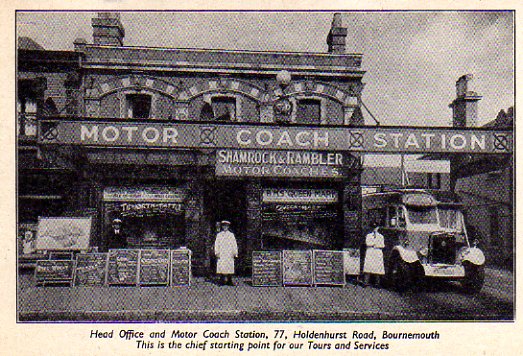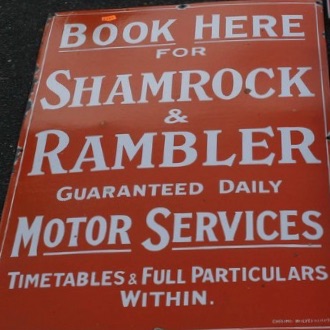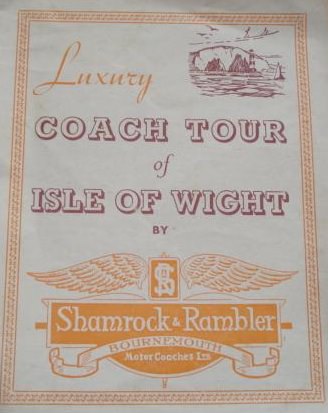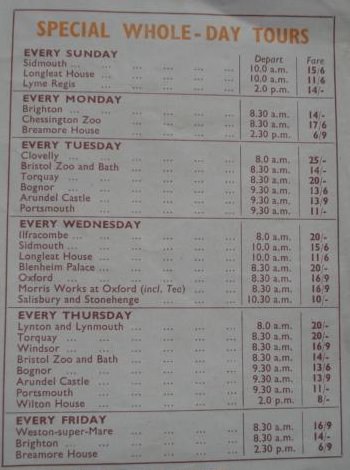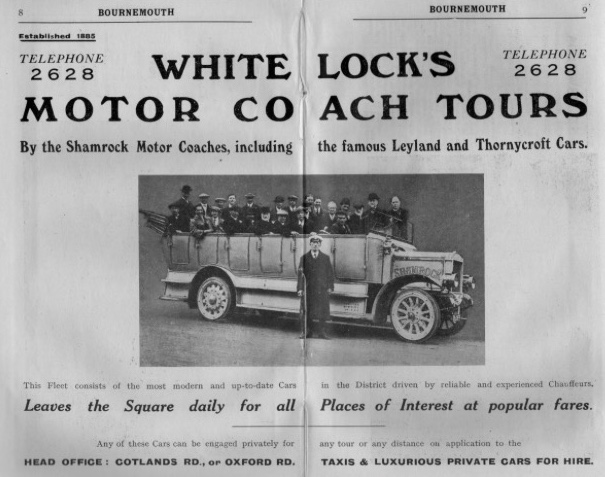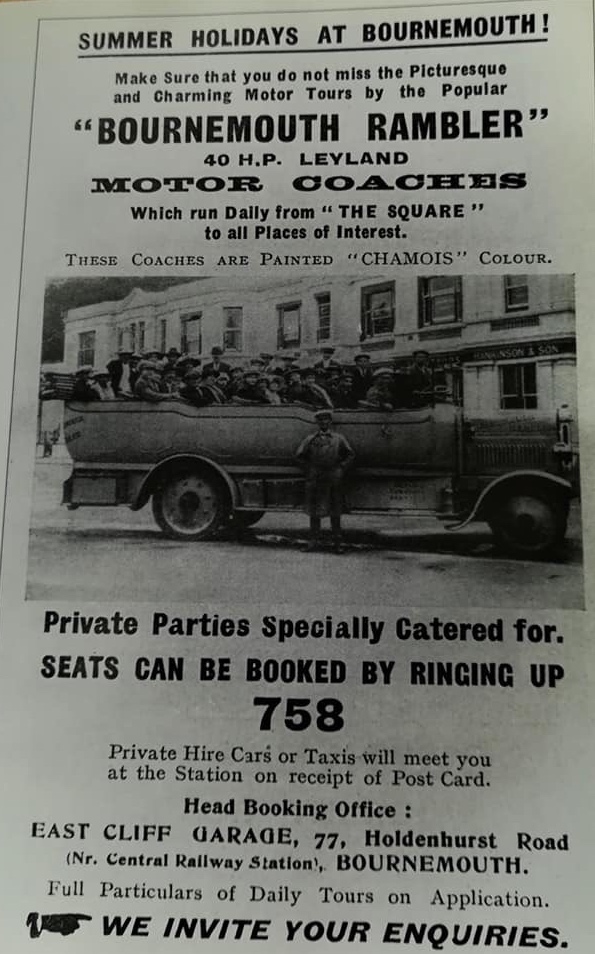SHAMROCK & RAMBLER COACHES
As older readers may remember them
. . .
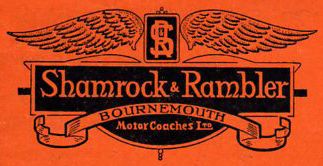
Coaching activities were expanded to also include operation from a Southampton base, and life went busily on in the coaching business through the 1930s. The fleet size had reached 29 vehicles in 1934, of which 20 were Daimler CF6 (five seating 20 and fifteen seating 26) and 6 AEC Regal 32-seaters. The second world war brought its own demands for transport of workmen and military personnel. Post-war peacetime returned bringing with it the reintroduction of tours and excursions. In February 1950 the buses of the parent Red & White group were nationalised. Subsequently the Orange Luxury / Shamrock & Rambler business was to pass into joint management by George Ewer of Stamford Hill, London (better known as Grey Green) and United Transport Services in 1952 (which was the "rump" of the former Red & White group, formed to manage the remaining and overseas interests). Ewer obtained full control of Orange Luxury in 1953, but this long-established company remained as a subsidiary of the main Ewer company until finally wound up in December 1975. Orange Luxury vehicles had the privilege of carrying the royal crest, being suppliers of coaches to the royal household.
During the period 1951 to 1963 several vehicles were owned and operated for contract work by the original S&R directors Ransom and Whitelock, trading as SMP Screw Machine Products. The office address was given as 10 Boscombe Cliff Road in Bournemouth but the vehicles operated primarily in the High Wycombe and Marlow areas to support the SMP factory at Bourne End in Buckinghamshire. Coaches came second hand from either S&R Bournemouth or Brighton Motor Conveyances, and all the SMP vehicles were Bedfords (WTB / OB / SB).
Like S&R, Brighton Motor Conveyances was another wholly owned subsidiary of Keith & Boyle (London) Ltd whose main business was the Orange Luxury Coaches range of express services from London. The Orange business included six or so express Journeys between London and Brighton and also provided for a 9 a.m. departure from Brighton with an evening return from London. In Brighton their coach station was the Aquarium Garage, an imposing building on the sea front. Whilst BMC had one or two coaches based in Brighton for use on excursions they also employed coaches from London during their long lay-overs for excursions. Southdown bought the BMC business from Keith & Boyle and took over on 19th March 1963, the value being in gaining extra local authority plates and more front positions on rota for the coach rank just east of the Palace Pier.
The timetable illustrated below for the London express service dates from 1954. It was to remain largely unchanged throughout early post-war years and is almost identical with that for 1946. The additional "C" journeys running only on 3 days a year, immediately before the bank holiday weekends, should be noted. But by 1957 the operation had been reduced to one single return journey a day with a London based Orange Luxury vehicle, from the capital in the morning and returning from Bournemouth in the late afternoon. A weekday single fare of 10/6 in 1946 had risen to 13/3 by 1957, with the day return only a few shillings more in both instances.
It was the practice at S&R to give their coaches names rather than fleet numbers, and this tradition dated right back to 1929. County names, girl's names, bird's names, all were used over the years on a fleet which had become almost standardised on the Bedford marque since 1936. AECs came into favour during the 1960s and Leylands from 1976. The fleet size was noted as 21 during the summer of 1972, fourteen Bedford / Duples and three Bedford / Plaxtons (SB / VAM / VAL), plus a Bedford 11-seater minibus and eight AEC / Duples. Coach sizes ranged from 37 to 52 seats, but were mainly 41 and 49 seaters. They bore a range of names of rivers, counties, birds and characters from Greek mythology: Avon, Chester, Falcon, Garnet, Hampshire, Kestrel, Medina, Medway, Merlin, Mersey, Orpheus, Oxfordshire, Raven, Severn, Skua, Stour, Swallow, Swift, Tamar and Wiltshire. Other 'name ranges' over the years (often associated with a particular make and model of vehicle) included girls names, astronomical names, the Greek alphabet, Roman towns, insects, wild animals, composers, big cats and French towns!
Charlies Cars, a long standing Bournemouth coaching competitor with a fleet of twenty-six coaches, was taken over by Shamrock & Rambler in 1963 (the founder Charlie Pounds had died five years previously). For some years after the two coach businesses continued to operate independently with the Charlie's Cars plum and spilt milk livery surviving until 1972. The other main coaching competitor in Bournemouth was Excelsior Motorways, founded in the 1920s by the Maitland family, with an extensive range of local day tours and extended holiday tours at home and abroad.
1966 saw Shamrock drawn into the nationalised transport network consequent upon Tilling buying the shares of United Services Transport, placed locally now under the control of Hants & Dorset Motor Services of Bournemouth. In 1969 the S&R operation from Southampton was closed and absorbed by Hants & Dorset. Then in 1974 coaching activites and liveries were standardised into the white of National Travel South West, and S&R orange and cream disappeared. Further change in 1983 came with the splitting up of Hants & Dorset and re-establishment of Shamrock & Rambler as a coaching unit. I recall working with local managers John Catt and James Freeman at the time.
Deregulation of local buses following the Transport Act of 1985 led in October 1986 to the revival of the Charlie's Cars name by James Freeman (S&R managing director at the time) for use in a new activity, the introduction of green and white minibuses on what grew to be a network of local services in and around Bournemouth, Christchurch and Poole. Then as part of the government's sell-off of the National Bus Company subsidiaries Shamrock & Rambler were purchased by Drawlane, itself a subsidiary company of contract cleaning firm Endless Holdings of Salisbury, for £0.7 million pounds. That took place on 6th July 1987 whilst Ray McEnhill was chairman (Drawlane was the company that would eventually become British Bus in 1992 and subsequently become part of the Cowie Group, which later became Arriva). This was Drawlane's first acquisition of a transport business.
At that time S&R operated forty-four coaches and twenty-nine minibuses with a staff of one hundred and ninety. But as soon as December 1988 the Charlie's Cars operation was abandoned by the new owners. Once again activity was focused on coaching, both tours and express work, but this was at a time when traditional coaching was beginning to decline. In September 1988 the coaching fleet had numbered forty-five (including fifteen MCW Metroliner double-deck coaches) but the significant loss of National Express contracts at the end of April 1989 led to the closure of the Shamrock & Rambler business.
The illustrations below recall some of the Shamrock & Rambler coaching activities of both the 1930s and the 1950s.
| Timetable for the Bournemouth -
Southampton - London
express service
for the summer of 1954 (the additional "C" journeys operating only on the day preceding a holiday weekend) |
|||||||||||||||||||||||||||||
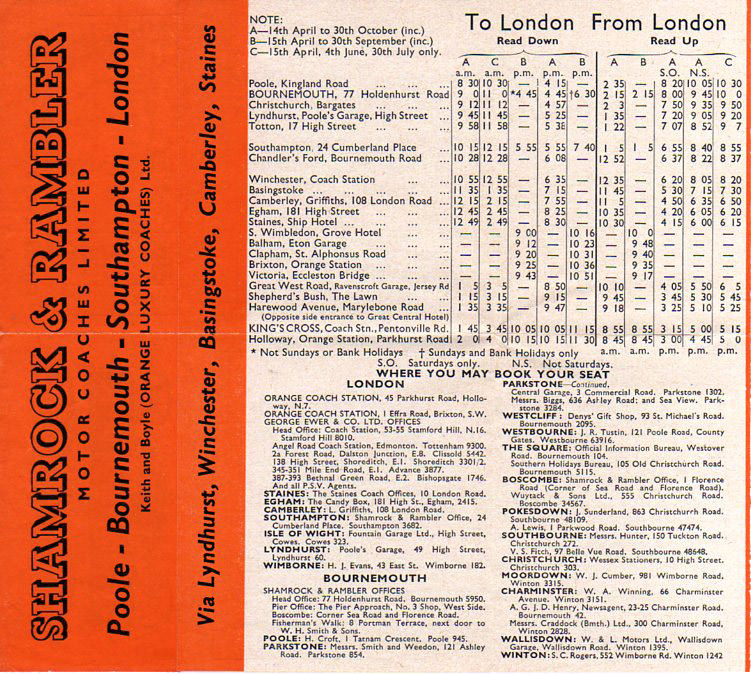 |
|||||||||||||||||||||||||||||
| Day tour listing from the year 1954 |
|||||||||||||||||||||||||||||
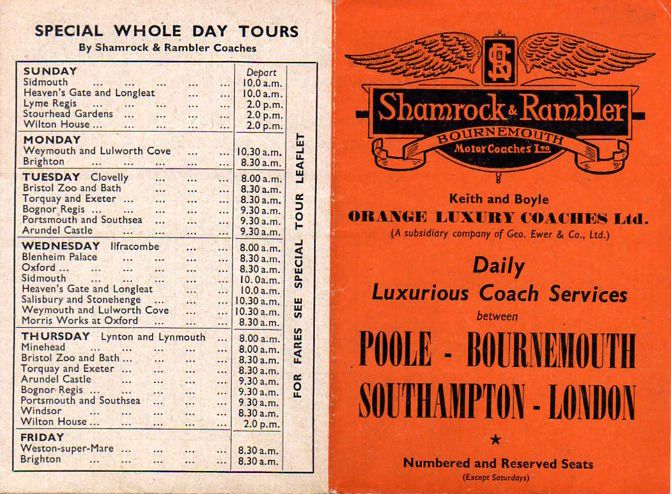
|
|||||||||||||||||||||||||||||
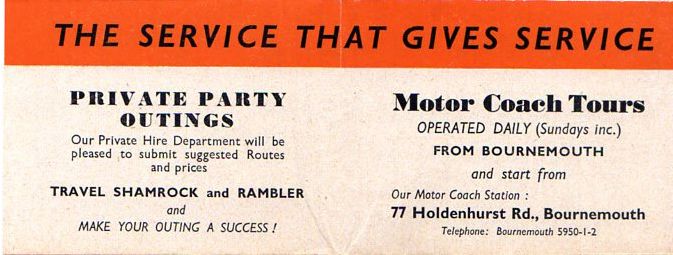
|
|||||||||||||||||||||||||||||
| Postcard from Boscombe showing a Shamrock
& Rambler coach |
|||||||||||||||||||||||||||||
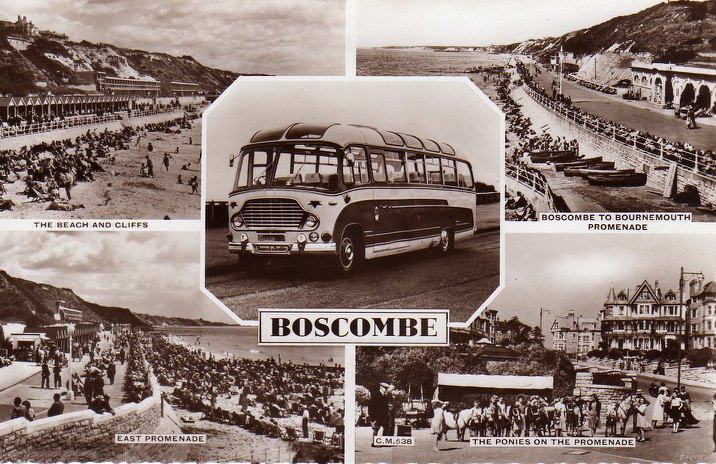
|
|||||||||||||||||||||||||||||
| The
cover of a 1930s booklet describing
the S&R offering of day and half day tours |
A later leaflet, cleverly paged to open at
the selection of the type of tour sought by the enquirer |
||||||||||||||||||||||||||||
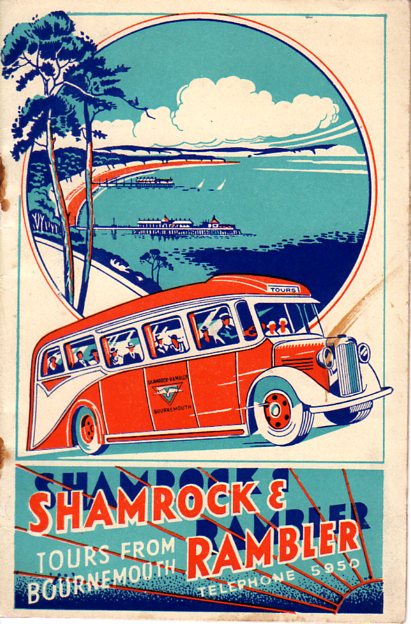 |
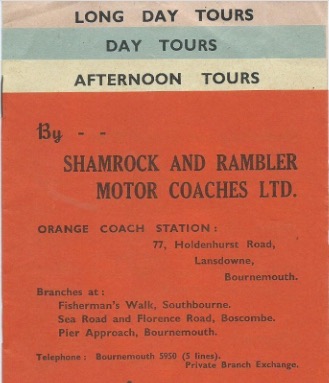
|
||||||||||||||||||||||||||||
|
|||||||||||||||||||||||||||||
1930s timetable for the three times daily service to London
|
|||||||||||||||||||||||||||||
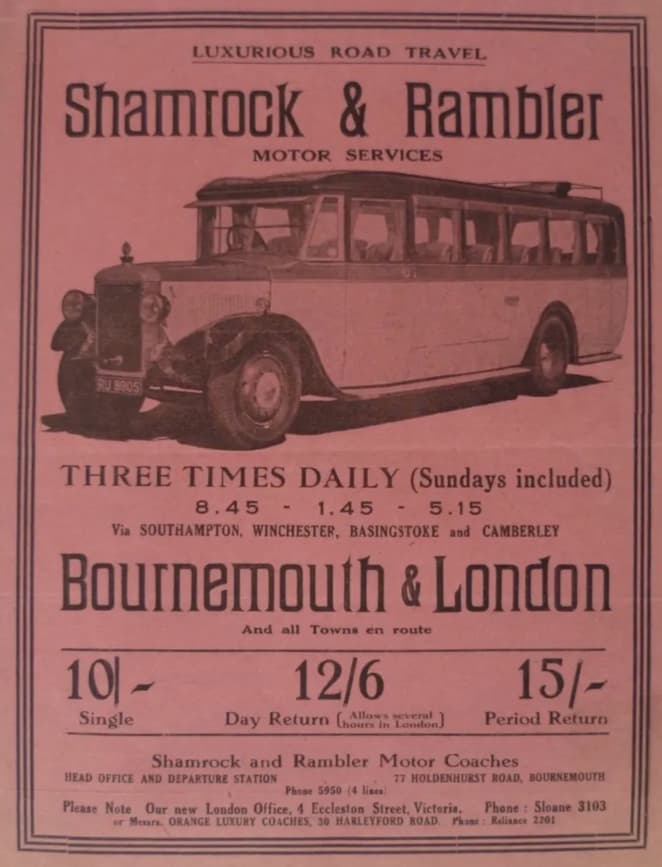 |
|||||||||||||||||||||||||||||
| for more reminiscences of the past coach operators of Bournemouth follows these links |
|||||||||||||||||||||||||||||

|
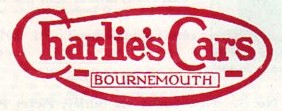
|
||||||||||||||||||||||||||||
|
|||||||||||||||||||||||||||||
